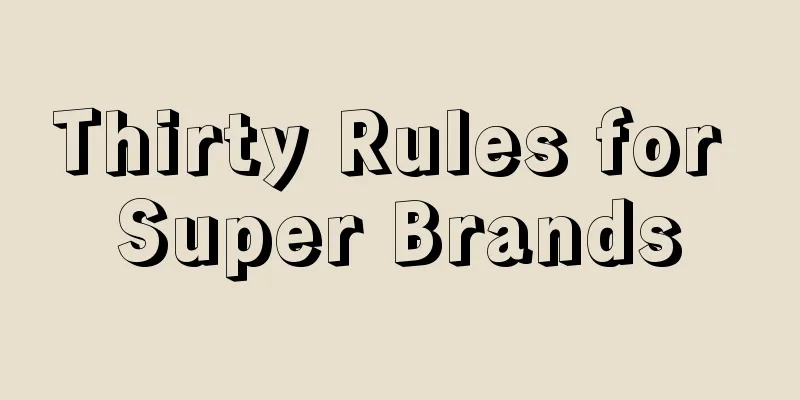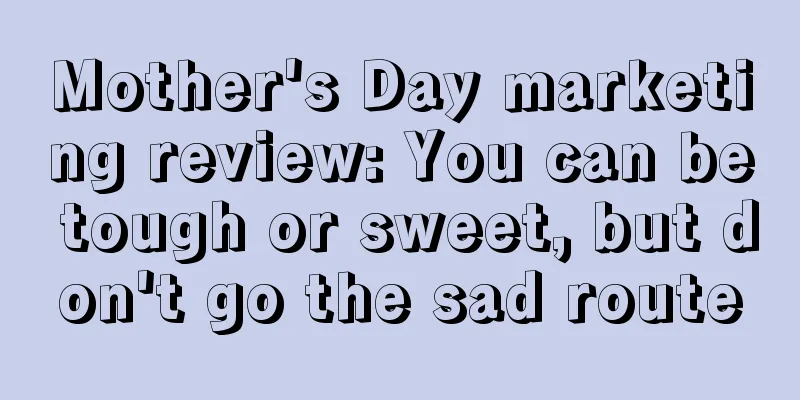Thirty Rules for Super Brands

1. The first military rule: No matter how lofty the mission and belief of a brand is, from the day it is born, it exists to serve business. Entrepreneurs must always know where the business of the corporate brand comes from? Who are the brand's customers? What kind of value are we creating for customers? Are customers willing to share the value created with their relatives, friends, and colleagues around them? 2. The second military rule: To create a new brand, you must focus on the "new" and give the brand an unprecedented sense of freshness. Only with freshness can you quickly and effectively enter the market. Xiaomi entered the market by relying on "born for fever" and "extreme cost-effectiveness", bringing an unprecedented sense of freshness to smartphones. Zhong Xuegao entered the market with a tile-like design, high prices and other freshness, which made consumers shine. However, when Huawei's cars were launched, they failed to make consumers feel bright, so the sales volume could not be too impressive. Successful brands all follow this rule. 3. The third rule: When building a brand, do not blindly pursue new advertisements. Only by adhering to a consistent style and tone can a brand have soul. Brands are like people. Only immature people always like to play tricks. Mature people will stick to their own style. One voice, one image, consistent, is the key to the success of a brand. 4. The fourth military rule: Good insights and big ideas are hard to come by. When a brand encounters a big idea, it should cherish it, keep it, and never change it. If there is no big idea, but only a small idea, the brand should cultivate it and turn it into a big idea. Wait for it to explode one day. Red Bull’s “When you are sleepy or tired, drink Red Bull” is a big idea. Unfortunately, internal disputes allowed Dongpeng Special Drink to take advantage. Mixue Ice City’s “You love me”, “I love you, Mixue Ice City is sweet”, and “Snow King” are all small ideas, but the company has patience, continues to cultivate, and continues to operate, and eventually detonated them into big ideas. 5. The fifth rule: Brand proposals do not need to be too complicated. You just need to explain clearly what it is and why. Less is more. 6. The sixth rule: The key to finding the right position is to figure out who I am for, what I am, and what I can give you. 7. The seventh rule: A small difference is far more powerful than a big demand. We created a green wasabi for King wasabi, which has a market share of 75% in China. The difference we found is "spicy and spicy, it's King wasabi"! It is a little bit spicier than Japanese table wasabi. This small difference is magnified and becomes a huge sales force in the market. 8. The eighth military rule: Product positioning is to define the competitive advantage and business scope of the product, that is, what group and what kind of business to do. In this regard, P&G is the master. No matter how bad the industry is, in terms of product positioning, it is almost impossible to surpass it in the foreseeable future. Evergrande's Evergrande Ice Spring is a huge failure in product positioning. 9. The ninth military rule: Market positioning is to define market segmentation and the source of business, that is, what kind of business you do. If the market positioning is clear, your public relations, promotions, activities, communications and internal operations around the market will reduce a lot of wasteful actions. 10. Article 10: Communication positioning, defining the key elements that make up the brand and forming brand discourse, considering how to make the target audience form preferences. When Pepsi and Coca-Cola faced off, the slogan "a new generation's choice" perfectly explained the importance of communication positioning. 11. The eleventh military rule: The basic spirit of brand strategy is to choose a path. Without choice, there is no direction. Once you choose a direction, stick to it and continue to improve. The right path is found by walking on it. Giving up means making mistakes. 12. Catch-22: The source of customers is sometimes related to the purpose of using the product. If a product is not sold "right", it cannot be sold "well". When Wanglaoji was still sold as a traditional herbal tea for curing diseases, it did not sell well. If Melatonin was sold as a traditional health product instead of a gift, it would not be the masterpiece it is today. To gain customers, spend more time thinking about what our products can be used for, and which use can gain a large number of user groups. 13. Article 13: Products with premium ability are brands, and personification elevates products into brands. Bargaining has two meanings: the first meaning is that you can sell the same type of products at a higher price than your peers. The second meaning is that the same type of products have the same price as your peers, but when put together, more people are willing to spend money to choose your products. Brand building is to personify physical products and give them image, personality, values and other connotations. 14. Catch-22: Preference completes transactions, partiality generates loyalty. So, please remember that you can’t serve all consumers, you can only choose and focus on a group of people. This is true even for so-called “national brands”. 15. Catch-15: When creating a brand, remember these five methods. The first method is to create a moving brand proposition; the second method is to maintain a consistent brand personality; the third method is to create an extraordinary brand style and tone; the fourth method is to project the goodwill behind the brand; the fifth method is to provide a brand story that people are willing to participate in. 16. Catch-16: Brand proposition is not about social welfare and a better life, but about the commanding heights of the interests of the product category. A brand proposition that cannot express the interests of the brand category is a "waste of money". 17. Catch-17: What really captures people’s minds is not the differentiated interest points, but a moving value that is highly consistent with the brand spirit. 18. Catch-18: In social communication, the brand’s attitude and tone should not be lost. Only in this way can bias and preference be formed. 19. Catch-19: The change of customer decision-makers is the biggest obstacle to maintaining style and a challenge to human nature. But remember, the basic needs of human nature have not changed in 1 million years. 20. Catch-20: You must know that there are some areas that brands must not touch. If you touch them, you will die. 21. Catch-21: The brand story should describe the original reason for the brand’s existence, rather than spending too much space describing the hardships and difficulties of starting a brand. 22. Catch-22: First there is friendship, then there is transaction. Making friends with customers will never go out of style. 23. Catch-23: Any work that goes through too many levels of review is likely to be mediocre. If the founder of a company wants his brand to be outstanding, he must make decisions personally. 24. Catch-24: Customers don’t care how much you know, they only care about how much you care about them. 25. Catch-25: Word of mouth is extremely important, core circle users are extremely important, and whoever’s consumers are the best at telling stories will have the strongest brand. 26. Catch-26: The closer the content used to create word-of-mouth is to real-world life scenes, the better. 27. Catch-27: A good brand strategy is not just a logical deduction, but requires innovative insights and ideas. 28. Catch-28: For brand integrated communication, the budget should start with building a creative platform. Do not divide the budget into so-called traditional media and new media budgets. 29. Catch-29: Don’t try to persuade consumers with advertising; use advertising to influence consumers as much as possible. 30. Article 30: Taste is the soul of a brand. Humans are born with the ability to perceive taste. Taste requires money and time. Even if you cannot create taste, you must not create vulgarity. Taste can help sales and make advertising more convincing. Taste cannot tolerate impurities. Taste is an extension of a single message. Author: Liu Yichun, WeChat official account: "Liu Yichun's brand product innovation" |
<<: What changes will AIGC bring to 4P marketing?
Recommend
What is the delivery process of Shopee's local stores? Process Introduction
Merchants who run local stores on Shopee must conf...
Can Amazon sell virtual items? Is it easy to sell virtual items?
The profit margin of physical products is actually...
Amazon Japan will extend product return period from November to December
Amazon Japan announced that for Amazon direct and ...
After launching the “9.9” offer, can Taobao no longer handle the situation?
This article starts from Taobao’s recent move to r...
What does an Amazon merchant manager do? What is an account manager?
Today I will introduce you to the content of Amazo...
Don’t know what type of notes to write on Xiaohongshu? Read this article quickly!
Do you have no idea what type of notes to write wh...
Without working for ten years, you can’t come up with such a touching marketing case.
This article covers the actual operations of many ...
After 5 years as a sweet potato blogger, I have summarized 83 valuable experiences
As a sweet potato blogger with 5 years of experien...
Xiaohongshu’s category scene content is becoming ineffective…
As consumer demand shifts from category-driven to ...
Women's clothing sizes are getting smaller and smaller, but brands can't go down a narrow path
The brand path should choose the appropriate route...
What does it mean when a cross-border e-commerce order is closed? What is the difference between an order being canceled and closed?
In cross-border e-commerce, sellers and buyers oft...
Does the new Amazon store make money? How to operate it?
There are many domestic seller friends who want to...
What are the Amazon smart advertising platforms? Introduction to the nine platforms
It is quite common to promote on the Amazon platfo...
What kind of value does WeChat’s heavy focus on search bring to brands?
In the development of the Internet, "search&q...
How to use data to mine potential users?
This article mainly focuses on the ways to use dat...









